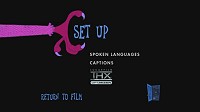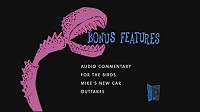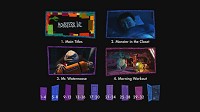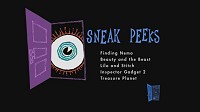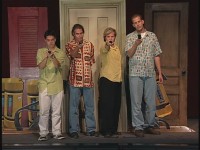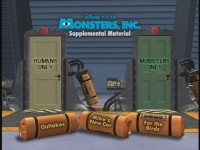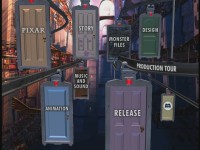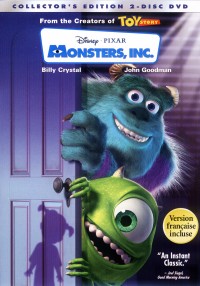
3.2.2014 #574
German Originals from
16.10.2002 & 6.8.2007
by Guido Bibra
• Filmmaker's Audio Commentary
• For the Birds - 2001 Academy Award Winner for Best Animated Short Film
• Finding Nemo - An exclusive Sneak Peek of Disney/Pixar's Simmer 2003 Feature Film
• Hilarious Outtakes and The Monsters, Inc. Company Play
• Train for your first Day at Monsters, Inc.
• See the Monsters, Inc. Employee Handbook
• Learn the History of the Monster World
• Play Peek-a-Boo - Boo's Door Game
• Check out fun-filled Facts and much more!
• Never-before-seen Deleted Scenes
• 3D Location Flyarounds
• Monstropolis Art Gallery featuring hundreds of Images
• Animation Gags and Guide to "In" Jokes
• Behind the Scenes of If I didn't have you -
![]() The Movie
The Movie
James P. Sullivan (John Goodman) and Mike Wazowski (Billy Crystal) are employees of Monsters, Inc, a company delivering energy for Monstropolis, the biggest city of the monster world. Sulley's job, assisted by Mike, is, like many other terrifying monsters, to go through the closet doors of the world's children and frighten them to convert their screams into energy. The monsters are not actually dangerous and even convinced that children are highly toxic - the company has many security protocols in place to ensure that no child ever enters the monster world accidentially. But this is exactly this what happens when Sulley and Mike notice that their co-worker Randall (Steve Buscemi) does a little after-hours work to push his scream quota. One door is left open unattended and suddenly Sulley and Mike have a little girl on their hands...
After Disney and Pixar had firmly seized the market of computer-animated movies in 1995 with Toy Story, competition was not far away when Dreamworks and PDI followed three years later with Antz, later landing their first huge success with Shrek in 2001. At this time, the similarity between the studio's movies was heavily discussed, because the parallels between the two insect stories A Bug's Life and Antz were very conspicuous. The movies were, however, so different in plot and characters that they could not be seen as plagiarism. Even so, the next projects of the studios were watched very closely - with Dreamworks developing the green monster Shrek and Pixar creating a whole army of monsters for Monsters, Inc. the rivalry between the studios had not come to and end at all.
A new Idea and a new Team
The basic idea of Monsters, Inc. had already been around at Pixar since 1994, when the concept was one of the several thought up during a lunch meeting of John Lasseter, Pete Docter, Andrew Stanton and Joe Ranft. It was Pete Docter who thought of a similar childhood fantasy as in Toy Story, except now it was not toys coming alive when a child leaves the room, but monsters coming through the closet door. It was Pete Docter's own project and he was always tapped as the director, but it was decided to temporarily shelve the project until animation technology had more improved. Although Monsters, Inc. had originally been planned as the successor of Toy Story, instead Pixar concentrated on A Bug's Life and Toy Story 2.
After several years of pre-production, the work on Monsters, Inc. began in summer 1998. True to his word, studio founder and director John Lasseter decided to leave the director's chair for someone else and laid the movie into the hands of its original creator, Pete Docter. Because of the size of the project, two co-directors were attached to the movie - longtime Pixar animator Lee Unkrich and animation legend David Silverman. He had begun his career in the late 1980s as one of the driving forces and first animators of The Simpsons and had even worked during the production of Monsters Inc. for Dreamworks on their traditionally animated movie The Road to El Dorado.
While the director's chair of Monsters, Inc. was shared by three real professionals with lots of animation experience, the script writing team was a more mixed affair. The legend is that the first incarnations of the story were cooked up by director Pete Docter with the help of storyboard artists Jill Culton and Jeff Pidgeon, who also got some additional help from Pixar animator Ralph Eggleston. Although the script was credited to another old Pixar hand, Andrew Stanton, together with the relatively unknown television author Daniel Gerson, an additional trio of people from outside the studio was also involved: Robert L. Baird, Rhett Reese and Jonathan Roberts were probably only a few of the many people who were working on the script, which reportedly existed in dozens of different variations at some point.
Little and Big Monsters
Parts of the concept of the movie were not really new and had already been used in the 1989 movie Little Monsters (coincidentially written by Terry Rossio and Ted Elliot, who later worked on Dreamworks' Shrek), where the monster world did not reside behind closet doors, but under the children's beds. The the basic idea was the same and later Pete Docter even admitted that he had once seen the movie and it might have been an unconscious influence on his idea. To be fair, everything else besides the very basic idea was original, especially because Docter wanted to portray the monster world not as simply creepy and frightening, but as a fully independent parallel universe not entirely dissimilar to the real world. Showing that monsters are just normal people like you and me was one of the big differences Pixar made in their movie.
Unfortunately. despite the amazing scenery and the original characters, the plot had some very obvious weaknesses and stayed far behind what would have been possible, mostly because of the influences of Pixar's parent studio. The story limits itself to a single quite simple plot, which would have been entirely children-friendly like any Disney movie, if the authors had not worked in a strong satiric subtext and a lot of snarky dialogue. Compared to previous Pixar movies, Monsters, Inc. Has a surprising amount of humour and references exclusively geared to adult viewers - secret company conspiracies, the energy crisis and a lot of other little ideas would have been simply impossible in earlier Pixar movies. This was a bold move for the studio which was not repeated until many years later.
The movie's story had been constructed around a number of set pieces, which were only loosely connected by a plot - but the real strengths of the script were able to successfully distract from these shortcomings. For a Pixar movie, Monster's Inc. had a very high amount of clever and funny dialogue, which contributed a lot to the satirical and even cynical atmosphere. The script leaves the impression that the authors had somewhat neglected the story itself to do more work on the dialogue - which this is not bad in itself, it seems really obvious with Monsters, Inc.
A fully original World
As a computer-animated movie, Monsters, Inc. is, of course, visually especially remarkabe, because Pixar had made a huge effort to create the scenery and the characters as detailed as possible. The CGI technology had already reached its heights in 2001 and allowed the animators to create a really realistic environment for the first time - the worlds of Toy Story and A Bug's Life were comparatively primitive. The monster world was not really designed as something completely alien, because Monstropolis is just a completely normal city - only with some very different inhabitants. The factory buildings of Monsters, Inc. were equally realistic and looked almost ordinary with a healty sense of realism, but also a dash of clever playfulness, making the main scenery of the movie something to really look at.
While the background design of Monsters Inc. is certainly impressive, the designers have even been more creative with the characters. The monster theme was practically an invitation for the animation team to have as much fun as possible, but the story's protagonists are not really frightening and instead became quite lovingly designed homages to classic monster portrayals. The level of detail most of the characters except some of the smaller background figures have is astonishing and even Mike, who is basically just a green ball with arms, legs and an oversized eye, has more features than apparent at first glance. Of course, it's Sully who is the real looker with his surprisingly realistic blue fur, which has a lot of dynamic movement itself. While both their overall look is pretty simplistic, they share one very important characteristic with all their monster co-workers: they have a very distinct facial expressions. Almost overwhelming is also the sheer variety of different monsters in the movie, which must have been a monumental design effort owing to the huge creativity of the designers.
Only the very few human characters, including Boo, the little girl which worries Mike and Sulley so much, are not much too look at and don't seem to have evolved much beyond Toy Story. While Dreamworks was already capable of rendering almost completely realistic humans in 2001 for Shrek, Pixar seemed to have taken the easy way out and just kept their earlier designs without improving them much. While there has been a lot of improvement in the hair department, the faces are still much too artifical, puppet-like and especially in case of Boo even look a little eerie. In contrast to the wonderfully designed monsters, the human kids in Monster's Inc. are a visual disappointment.
Voices from the Closet
Similarly to their rival Dreamworks, Pixar has always liked to hire the Hollywood elite for the voices of their animated characters, only making exceptions occasionally. Although Monsters, Inc. had again been cast with some very big names, the choice was remarkably excellent. The biggest challenge was casting the two leading characters, but in the end it did not prove to be very difficult.
Sulley, the big furry monster with the full name of James P. Sullivan, was originally to be cast with comedian Bill Murray, but pure chance prevented him to be hired because he had lost the phone number of the filmmakers and was not able to contact them in time. Meanwhile, Pixar had chosen John Goodman, who was ideal for a physically large monster like Sulley with his deep, booming, but still friendly voice - and as a former standup comedian he had exactly the right humouristic sense and timing. Sulleys assistant and best friend Mike Wazowski is the exact opposite of his partner, a role perfectly made for another ex-standup like Billy Crystal, who had always regretted turning down the role of Buzz Lightyear in Toy Story and was now given another chance by Pixar. Goodman and Crystal were able to record a lot of their dialogue together in the sound studio, making the interaction between Mike and Sulley especially lively and often creating an atmosphere not unlike a comedy stage show.
Although Monsters Inc. is not really an ensemble movie and Mike and Sulley are clearly the main protagonists, the voices of the numerous secondary characters were equally carefully chosen. The voice of the little girl called Boo was not provided by an actress, but by Mary Gibbs, the two-and-a-half year old daughter of storyboard artist Rob Gibbs, making the girl's babbling completely authentic. While her moments are also very natural, her face and expressions are not because of the limited design and animation, which is expecially disappointing since she is present in most of the scenes of the movie.
The major antagonist of the story is Randall Boggs, but as a multi-limbed chameleon with an extra-wide grin he is not really terrifying and even responsible for a little bit of slapstic. His voice is Steve Buscemi, an actor known for mostly portraying shifty characters, making Randall more satiric than fearsome and evil. Short, but impressive is also the appearance of company boss Henry J. Waternoose, an overdimensional crab monster with the distinctive voice of none other than James Coburn. It was one of the very last roles of the actor who had unfortunately passed away in 2003 and his only appearance in an animated movie, giving Monsters, Inc. a real touch of class and one more prominent voice.
Mike's girlfrield Celia, actually one of the more human monsters of the whole menagerie, is voiced by Jennifer Tilly with a disarming squeakiness, while the grumbling sectretary Roz is provided by storyboard artist Bob Peterson, whose temporary acting was so good that it was never replaced and stayed in the movie. Also not voiced by actors, but by script writer Daniel Gerson were the two bumbling workers Smitty and Needleman, while puppeteer and voiceover legend Franz Oz has a little, almost unrecognizable role as Randall's assistant Fungus. And, of course, John Ratzenberger has his by now traditional guest role, this time as the Abominable Snowman, a friendly yeti-like monster who had been banned into the real world for some unspecified crime.
Newman and the Monsters
For the musical accompaniment, the filmmakers did not take any risks and went to the one musician who had composed for all previous Pixar movies: Randy Newman, who had begun his career in the 1960s as a pop musician and songwiter and later became a successful film composer in the 1970s. His previous works for Pixar were always somewhat classic and even conventional, but for Monsters, Inc. Randy Newman had revisited his jazz roots and created an outstanding film score with a real big band flavour and a handful of catchy themes. The jazz-combo title tune sets the tone of the movie early before the music changes to big-band swing sounds and later even quite traditional orchestral scoring, but it sounds always fresh and surprising. Newman works hand in hand with the plot and editing, providing a wonderfully unique atmosphere to the movie.
As a songwriter and pop musician Randy Newman always likes to put one or more songs into his film scores, but apart from a somewhat tongue-in-cheek exception, Monsters, Inc. Is completely free of any singing. Only in the closing credits the vocal version of Randy Newman's title tune, called If I Didn't Have You, is heard as a brilliantly funny duet between John Goodman and Billy Crystal. It is actually a quite simple song with a basic structure, but the humorous interpretation of the two actors and Randy Newman's great arrangement ending the story in the same playful way it begins during the opening credits.
A Monster Success?
The CGI animation duel of the year 2001 ended with a neck-and-neck race when Pixar had the sense of not directly competing with Dreamworks' Shrek in the spring, instead opting for a November release in time for Halloween. While Shrek had broken some records at the boxoffice, Monsters, Inc. had come out with a distinct lead maybe because of the better timing. But the critics were definitively more in favour of the competition, because some questioned Pixar's approach to a more adult-compatible humour and cited the weak storyline of the movie. The detailed animation and the humour were, however, recognized as the strongest points of Monsters, Inc. and in the end the movie was still able to become the highest-grossing production of Pixar, until it was succeeded by Finding Nemo and The Incredibles.
The newly introduced category for animated movies at the Academy Awards of 2002 did not go to Monsters, Inc., but, as expected, to Shrek - although Pixar was surprisingly able to win in another category. After many unsuccessful nominations, Randy Newman won the first Oscar in his career for his title song If I Didn't Have You, which was sung live on stage at the award ceremonies by John Goodman and Billy Crystal. The movie was also nominated for best film music and best sound editing, but was not unfortunately not able to prevail against the competition.
Overall, Monsters, Inc. is not really a typical Pixar movie and is perhaps one of the few movies of the studio most approaching the style of its competitor Dreamworks, something which highly unusual for a Disney production. Outstanding animation, brilliant characters with striking voices, enormeously funny dialogue and a swinging film score are easily able to counterweigh the somewhat weak plot and make a real Pixar classic out of Monsters, Inc. even appealing to those who normally do not like the studio's movies. But while Dreamworks was able to turn Shrek into a successful franchise spanning four movies over almost a decade, Monsters, Inc. remained a one-off venture for a long time until Pixar finally decided to go for a prequel in 2013 after several previous attempts.
![]() The DVD
The DVD
Almost a full year after Shrek had stormed the home video market at the end of 2001, Pixar had finally followed up with Monsters, Inc. The unusually long delay was not really understandable, because the bonus materials were quite extensive, but not so much that their production would have needed a whole year.
There was only one DVD release in the USA at the beginning containing everything: all the bonus materials including both widerscreen and fullscreen versions. In Germany and some other European countries, Disney chose a more disappointing way and released a single-disc DVD containing only minimal extras and the fullscreen version, while a double-disc Deluxe Edition, aproxximately resembling the US release, was available for a much higher price, but also a huge drawback: the bonus materials were completely dubbed into German without the English original available. This version has been out-of-print for a long time and has been replaced by a Special Collection, which sadly is just the fullscreen version with the reduced extras - and until today there is no other version available in Germany anymore, although there is a two-disc widescreen version still available in England.
The DVD reviewed in this article is actually from Canada and has two differences to the US 2-disc-release: the fullscreen version has been removed and the isolated effects soundtrack has been substituted with a french soundtrack. This is a bit annoying, because there would have been enough room for the effects track because of the removed fullscreen version, which was probably ditched because the outtakes and the short film also needed an additional soundtrack. Apart from this problem, the Canadian release is identical to the American Region 1 disc.
Monsters, Inc. has also been available as a Blu-Ray since 2009 and while all the extras of the US DVD release have been ported over, the German edition still suffers badly from the missing English soundtracks on the extras - it is highly recommended to import the Blu-Ray from England or the USA if you are ordering from a German-speaking country.


![]() Image
Image
After both Toy Story installments and A Bug's Life Disney had released its third full-digital transfer with Monsters, Inc. in 2002, something which was still quite new back then. The direct conversion of a digital film master needed a lot of experience, which Disney had already plenty of and so was able to deliver an almost perfect image quality on this DVD. There are, however, a few limitations due to some overzealous authoring.
Generally, the NTSC DVD version of Monsters, Inc. nevertheless has a brilliant image quality reproducing the digital master in almost the best way possible. Remarkable are the very strong colours and an astonishing depth, making the image almost jump through the screen. Without a detour over analogue film material the image quality is absolutely impeccable - there are, of course, no dropouts, dirt or film grain and even typical video artifacts like noise or colour bleed are not noticeable at all.
Sharpness is excellent, but on closer inspection and when viewing on bigger screens a slight electronic oversharpening is apparent, sometimes leaving double edges and giving the image a somewhat digital look. Why the already very detailed digital master was additionally sharpened is unclear, but it was probably done to give it a bit more edge on the CRT televisions which were still very much in use back in 2002. Perhaps Disney had a look at the slightly softer image of Dreamworks' Shrek DVD and decided to do it better - luckily the sharpening is not so bad that it becomes distracting. Nevertheless this DVD would have looked much better without it.
Also, the compression could be a little bit better - there are no real heavy artifacts, but sometimes blocking is evident on flat surfaces and some dark image parts seem to be surprisingly noisy. Because there are two full movies on the US disc, one in widescreen and the other in fullscreen, and this Canadian version uses the same compression master, the bitrate is not as high as it could have been because the free diskspace has not been utilized. Compression is something that Disney had only fully mastered with its animated movies years later and it's very evident that this early effort is still far from perfect.
Nevertheless, considering that this DVD is now over a decade old, the quality is still surprisingly good despite the unnecessary sharpening filter and the less than perfect compression. It is not known if Disney has put new masters on the recent re-released of Monster's Inc. or if this original master was re-used, but the Blu-Ray would certainly have the Edge over this old disc today.
![]() Sound
Sound
Pixar's fondness for detailed sound design is again apparent on Monster's Inc., whose sound is reproduced in Dolby Digital EX, but not in DTS on the North American DVD releases - the DTS tracks were only available on the European releases, but the Dolby tracks on this disc are still extremely remarkable.
Gary Rydstorms elaborate sound design and Randy Newman's jazzy film music provide a magnificent surround mix constantly filling all the channels. The mix uses less loud effects, but more detailed and selective sounds for quiet, but all-encompassing ambient noises predominantly on the frontal sountstage, but the surround channels are also frequently called into action. The sound design is very lively and natural and leaves almost no trace of the fact that it was completely created in a studio. The voices are not locked to the center channel, but often wander around on the frontal soundstage and even go to the surrounds a couple of times. This might seem irritating at first because directional dialogue had been out of fashion for decades, but Pixar has always tried to revive this old tradition and in Monster's Inc. it works perfectly as a part of the soundtrack.
Unfortunately the Canadian DVD had replaced the isolated music track with a french dub, although there would have been plenty room for both on the disc. Much more annoying would have been the removal of an isolated music track, which is unfortunately not present on any of the DVDs or even current Blu-Rays. Subtitles are only available in English.
![]() Extras
Extras
Pixar DVDs have always been interesting because of their elaborately produced bonus materials, and Monsters, Inc. is no exception in this regard. But like their previous DVDs, this one suffers somewhat from a very sugary and full of self-praise style aimed mainly at younger viewers - the grownup audience may feel more than a little patronized by this overzealous self-portrayal of the Pixar crew. But ignoring this, the extras are still nothing less than amazing.
The structure of the extras on the second DVD is, however, a little chaotic: instead of a bigger documentary the bonus material cosists of many small featurettes, image galleries and other stuff. This is not really a problem, but the sheer amount of material makes the whole disc somewhat confusing with some extras even appearing several times. The producers seemed to be aware of that and put a very helpful flowchart-like guide into the little booklet of the DVD. The menu design is pretty impressive, if sometimes a little too playful and lengthy - and the rendering quality on the second disc is noticeably bad.
The extras are beginning on the first disc with the scene-specific Audio Commentary by director Pete Docter, co-director Lee Unkrich, author and producer Andrew Stanton and Pixar boss John Lasseter. While the two directors are talking in a quite relaxed and friendly way about the making of the movie and have a lot to say about the story development and the process of animated filmmaking, the separately recorded Stanton and Lasseter concentrate on much more general topics and sometimes just fall into plain narration - and far too much self-praise. Sentences like "we're very proud of this" or "this os so great" are much too often heard and while this is almost normal on a Pixar commentary, here it nearly borders on arrogance and is neither funny nor entertaining. Pete Docter and Lee Unkrich are, however, taking care of not letting this get out of control and make this commentary very much worth hearing and one of the best from the studio.
For the Birds (3:23) is Pixar's Oscar-winning short film, which was often shown as an opening act for Monsters, Inc. in the cinemas. The film is presented on this DVD with a perfect anamorphic 1.78:1 digital transfer, a 5.1 soundtrack and even has an optional audio commentary by filmmaker Ralph Eggleston. In the short runtime, he has a lot to say about his simple and children-friendly movie, but is hardly as ostentatious as his colleagues on the main movie.
Mike's New Car (3:43) was newly produced for the DVD release and seems originally to have been an unused scene from the movie. It's a little slapstick comedy number showing that monsters even share the same fondness for expensive cars with humans. Sadly, this short film had been produced in 1.33:1 only, but it has almost the same good image quality as the main movie and also has a 5.1 audio track. The Audio Commentary, according to the menu by "Docter & Gould" is actually from the two young kids of the filmmakers - a funny experiment, albeit without much content.
The Outtakes (5:29) have been a Pixar tradition since their very first movie, but are not contained in the closing credits this time. Instead they are separately available on both discs and, like Mike's New Car, have only been rendered in 1.33:1, but also have a 5.1 track. There are some lovely surprises in there including some bits from the actual company play mentioned in jest during the plot.
Sneak Peeks has several trailers for movies and DVD, among them for Finding Nemo (2:04), which was the next movie coming out from Pixar.
The Soundtrack menu also has the THX Optimode Program for calibrating audio and video and the movie also begins with a new THX trailer.
The Second Disc begins with a short Intro (1:21) by directors Pete Docter, Lee Unrich and Davis Silverman, who appear in front of a camera to explain the structure of the DVD a little bit - this is actually necessary, because it's easy to get lost in the menus. Surprising is the low video quality of these scenes - Pixar may be able to render high-resolution CGI, but they don't seem to be able to record with a decent video camera. Also, everything on the second disc has been produced in 4:3, often using the re-framed fullscreen version of the movie for film clips, while some material has been letterboxed into non-anamorphic 1.78:1, which would have looked much better in 16:9.
Disc 2 is divided into the two main sections Humans Only and Monsters Only. The main menu also contains the Outtakes and the two shorts Mike's New Car and For the Birds, which are exactly the same as on the first disc with one exception: here, Mike's New Car doesn't have a French soundtrack.
Behind the door Humans Only is the lion's share of the extras, devoting itself to the making of the movie. In seven different sections everything about the production of Monsters, Inc. is contained and then some more.
The Production Tour (18:33) is actually not a standalone featurette, but a composite of the intros from the first five sections Pixar, Story, Monster File, Design and Animation. If these are watched here first, the first menu options from these sections can be skipped. The Production tour does have something special, though: if the long version is watched, a secret menu is activated in which diverse outtakes, removed scenes and other material can be viewed.
Pixar contains only the Pixar Fun Factory Tour (3:36) in which the Pixar crew, led by founder and boss John Lasseter, shows the viewer around their new studio environment. The overall impression is that this all looks a little too much fun - these people seem to have too much time and nobody seems to be really working!
Story
In Story is King (2:03) David Silverman and storyboard artist Bob Peterson explain how a story is transformed from script into storyboards and presented. In Monsters are Real (1:32) the filmmakers tell about their personal attitudes and experiences towards monsters.
The Original Treatment (13:43) is a rough animatic of colour drawings with a simple voiceover and temporary music soundtrack, representing a very early first concept of the movie.
Story Pitch: Back to Work Early Version (4:39) is Bob Peterson's storyboard presentation of a scene which looks somewhat different in the movie.
Banished Concept contains four scenes which had not made it into the final movie in the form of storyboard animatics, fronted by an Introduction (0:32) from Lee Unkrich: Assistant Sulley (2:16), End of Day (2:36), Bad Scare (3:01) and Scream Refinery (1:07).
Original Sulley Intro (0:59) is an almost completely rendered alternate version of the movie's beginning.
Storyboard to Film Comparison (5:42) does what it says on the label: a comparison of a scene in two stages of development - Storyreel Only has just the rough drawings, Final Color is the finished movie and Split Screen show them both together.
Monster Files
Cast of Characters (5:54) follows director Pete Docter into the sound studio where he meets his fellow filmmakers - and Bob Peterson, who not only creates storyboards, but also voices one of the minor characters. After this, the featurette becomes more of a commercial, because the following interviews with some of the actors and some footage of their work in the sound studio seem to have been culled from promotion material - it's entertaining, but not actually very interesting.
What Makes a Great Monster (1:26) is a very short introduction of the character designer team, who created all the various monsters of the movie. A few interesting examples are shown, but these can also be viewed in the following gallery.
Character Designs contains concept drawings of fourteen characters in altogether 216 images, which are complemented by so-called "Turnarounds", short 3D animations of the characters revolving by 360°. The image galleries have handy thumbnails and all drawings are presented full screen - an exemplary presentation.
Design
This section begins with the intro Monstropolis (2:51) with the filmmakers, who are mainly commenting on some concept art and are not really giving a good overview of this part of the extras.
Setting the Scene shows the work of the new Pixar department Set Dressing (3:24), where the work of real-life set designers is done - just virtually in the computer in this case. Step Through (28 images) demonstrates this in pictures of five scenes, which can be viewed in several stages of work.
Color Scripts is a collection of 71 wonderful colour paintings, which are covering almost the whole movie and have been used for the final lighting process. Master Lighting contains images from eight scenes viewable either as a coloured drawing or as a final render with lighting.
Location Flyarounds is one of the greatest highlights of this DVD. Special animations which literally fly through the scenery of the movie have been created - sadly only in 1.33:1, interlaced and reduced resolution, but these are still utterly fascinating: Downtown (1:10), The Apartment (1:23), Monsters, Inc. (3:07), Simulator (1:03) and Boo's Room (0:31) show the virtual locations in all their glory and are even accompanied with the appropriate sounds.
Monstropolis Art contains even more detailed drawings, concept art and other material. Door Station (9 ), Door Vault (9), Monsters, Inc. (18), Monstropolis (50) and Scare Floor (20 images) all have colour and black and white drawings of all kinds.
The Guide to In-Jokes is a helpful explanation of 21 hidden references and goes beyond simple trivia - there are not only the bare facts, but also a lot of visual hints which are barely noticeable in the movies.
Animation
Animation Process (3:14) shows with practical examplex, how storyboards are made into a finished animation. Early Tests (8:15) contains an almost finished test sequence and a couple of more rough-looking attempts, all with an Audio Commentary by animators Thomas Porter, Steve May and Michael Fong. The first scene, without the commentary, is also available in the Hidden Door Menu as an easter egg.
Opening Title Animation (2:09) is all about the traditionally animated beginning of the movie, whose making is explained by Pete Docter and Geefwee Boedoe. But only the very obvious is being discussed and it's almost unbelievable that the original source of the very distinct style, the title sequences of many Charles K. Feldman productions like What's New, Pussycat?, Casino Royale oder The Seven Year Itch is not mentioned at all.
Hard Parts (5:01) is not actually about something specific from the movie, but generally about the very complicated aspects of animation like Sulleys fur, the snowstorm and other things.
In Shots Department (2:15) effects supervisor Galyn Susman explains how camera setups are being planned and cut together.
The Production Demo (1:51) is a short scene viewable in four different stages of completion: Storyreel, Layout, Animation and Final Color.
Music & Sound
Monster Song (3:18) is a short, but fascinating featurette about the recording of Randy Newman's closing credits song, sung by John Goodman and Billy Crystal who are shown working enthusiastically in the sound studio.
Sound Design (4:16) begins with a rare view of Lucasfilms Skywalker Ranch (protected by barbed wire like a high-security prison), where the sound of the movie was created by Gary Rydstorm and his sound technicians.
Binaural Recording (1:12) is being heralded as something completely new here, but this sort of dummy head recording has actually been around for more than forty years. But the audio examples are really interesting, which should be listened to with headphones to get the full effect.
Release
The Premiere (0:58) is only shown very briefly, while Toys (1:32) lets the filmmakers go nuts with the merchandize of the movie. Posters has images of fifteen different film posters and the Outtakes are here again, but only exactly the same as in the main menu and on disc 1.
Trailers are of course indespensable on this DVD, but their presentation is disappointing. The Teaser Trailer (1:53) suffers most from this, because it was originally available in the Ultimate Toy Story Box in finest 16:9 and with 5.1 sound, while this version here only has an 4:3 letterbox image and mono sound - the latter is especially annoying, because the best gag of the trailer ist lost: the growling dog is heard from the surround speakers! Trailer #1 (1:52) has been assembled from existing scenes, while Trailer #2 (1:21) has a new sequence only shown here. Like the four thirty-second TV-Spots all these trailers have only a 4:3 1.85:1 letterbox image with 2.0 mono sound.
International Inserts (1:08) shows how elaborately all the text material of the movie has been translated into many different languages. But on this DVD, nothing of this is visible, because the movie has not been encoded with multi-angle parts even though it's a Canadian release. This was also not done for the German disc.
The Multilanguage Clip Reel (3:47) goes through many different languages into which the movie was dubbed beginning with German - and all sound positively awful compared to the original voices.
Monsters Only
Behind the second door the three sections New Monsters Adventures, Behind the Screams and Orientation are located.
New Monsters Adventures
The short Mike's New Car appears here for the third time, but of course it's still the same one. The Monster TV Treats (1:12) are six short, but enormeously funny television spots for several occasions like Christmas, Thanksgiving, Easter and others.
Ponkickies 21 is something rather strange: two short animations with Sulley and Mike, which Pixar had done for a Japanese television show. Janken (0:36) and Lucky Door Game (0:52) are therefore only shown here with a Japanese soundtrack with optional English subtitles, but this is nevertheless quite funny,
Peek-a-Boo: Boo's Door Game is a simple, but well-made interactive game, in which the player has to search for all the missing parts of Boo's door. Disney Storyline: Welcome to Monstropolis is a very small audiobook for younger viewers, in which twenty pages with a little scene drawing and one line of text can be either read by a narrator or by the viewer.
The If I Didn't Have You Music Video (1:14) is actually only a commercial for the soundtrack album and is even presented in 1.85:1, but has only mono sound.
The last option in this menu is a pointer to the DVD-ROM section of the disc, where ROM-versions of Boo's Door Game and Storyline are available, plus a hardly working demo version of another game. Sadly, there is nothing else in there, because Pixar had never really embraced the additional possibilities of DVD-ROM contents.
Behind the Screams
The Outtakes appear for the third time here, but sadly there is only one version which is replicated three times. The Company Play Program makes up for this, because the 23 pages of the theatre booklet are wonderfully designed and full of little reference worth reading - this would only have been more amazing if Pixar had included it in print. On the Job with Mike and Sulley (2:33) is the complete television special of which only a part is seen in the movie.
Orientation
Welcome to Monsters Inc (0:56) is the television commercial, which Mike and Sulley watch in the beginning of the movie, in its full version. Your First Day (3:36) has the corny style of an industrial instruction movie completely with fake 16mm film grain - but there is nothing new to see here, because it was cut together from film scenes, although it is still vey amusing.
History of Monster World (1:40) is just a rough black and white animatic with a somewhat dull voiceover explaining in a very basic way how the monster world came about.
The Employee Handbook consists of 35 pages with ID cards of the workers and scarers, survival tips from Roz and other funny things which were all quite elaborately designed. This is a lot of fun and gives a huge amount of entertaining background information.
Monsters of the Month is only a single picture of the wall with the monthly winners - eleven times Sulley and in December Mike finally got his chance. The Scarer Cards are fourteen funny collection cards of the stars from Monsters, Inc., each containing some basic facts about the scarers and workers.

